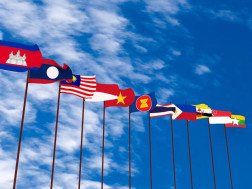While most investors tend to think in terms of G10 currencies, the world market offers attractive currency and investment opportunities in the south Caucasus nations of Georgia, Armenia and Azerbaijan.
Russian literary genius and Poet Alexander Sergeyevich Pushkin was fond of the Caucasus and quoted "The freedom of the Caucasus will be the grave of the Russian tsardom”
Pushkin had admiration for the spirit of freedom and resistance he observed among the peoples of the Caucasus, as well as his recognition of the challenges that the Russian Empire faced in trying to control the region. The Caucasus was a site of conflict and resistance against Russian expansion during Pushkin's time, and Pushkin’s quote captures the complex dynamics of power, conquest, and resistance in the region even in 2024.
The further-flung, smaller markets of the Caucasus tend to be driven by more country-specific sets of risks and potential rewards than the bigger countries, where investments are more sensitive to broad changes in global risk sentiment.
Investors should look at the wider universe beyond the traditional emerging markets. There’s a lot of interesting, attractive investment opportunities outside the conventional and traditional emerging markets universe.
The Caucasus region has been considered at the edge of empires. Namely the Russian empire, the Ottoman empire and the empire of Persia, modern day Iran I.R Iran Islamic republic of Iran.
The South Caucasus is a region situated at the crossroads of Europe and Asia, encompassing the countries of Armenia, Azerbaijan, and Georgia. It's characterized by its mountainous terrain, diverse cultures, and complex geopolitical dynamics. The region has historically been a nexus of trade and cultural exchange, but it has also been marked by conflicts, particularly over territorial disputes such as the Nagorno-Karabakh conflict between Armenia and Azerbaijan.
The South Caucasus countries—Armenia, Azerbaijan, and Georgia can de defined as:
Azerbaijan: Azerbaijan has the largest economy among the South Caucasus countries, primarily due to its significant oil and gas reserves. The country's currency is the Azerbaijani Manat (AZN). Its economy has seen growth and diversification beyond the energy sector in recent years, with investments in infrastructure, agriculture, and tourism.
Georgia: Georgia has a relatively diversified economy compared to its neighbours, with sectors such as agriculture, tourism, and manufacturing contributing to its GDP. The currency in Georgia is the Georgian Lari (GEL). Georgia has been pursuing reforms to improve its business environment and attract foreign investment.
Armenia: Armenia's economy is smaller compared to Azerbaijan and Georgia. It has a diverse industrial base, including sectors like mining, agriculture, and technology. The currency used in Armenia is the Armenian Dram (AMD). Armenia faces challenges such as geopolitical tensions, but it has also been working on economic reforms to stimulate growth and attract investment.
Azerbaijan generally has the largest and most developed currency market due to its larger economy, significant oil and gas resources, and greater financial infrastructure. The Azerbaijani Manat (AZN) is the currency used in Azerbaijan. Azerbaijan banks are said not to open accounts for non-residents.
Georgia also has a relatively developed currency market, particularly as it serves as a regional hub for trade and finance. The Georgian Lari (GEL) is the currency used in Georgia. Interest rates are between 9% to 10% on the GEL.
Armenia has a smaller economy compared to Azerbaijan and Georgia, but it still has a currency market for the Armenian Dram (AMD). However, its market may not be as large or as developed as those of Azerbaijan and Georgia.
Overall, while Azerbaijan and Georgia have more prominent currency markets within the South Caucasus region, each country's market size and development level can vary based on factors such as economic size, financial infrastructure, and international trade relations.
The word "manat" is derived from the Latin word "monēta" and the Russian word "монета" ("moneta") meaning "coin".
Georgia also has a relatively developed currency market, particularly as it serves as a regional hub for trade and finance. The Georgian Lari (GEL) is the currency used in Georgia. The name lari is an old Georgian word denoting a hoard, property, while tetri is an old Georgian monetary term (meaning 'white') used in ancient Colchis from the 6th century BC. Georgia allows non -resident accounts.
Georgia has two of its large banks listed in western capital markets, UK London listed BGEO bank of Georgia Group and TBC Bank Group PLC (TBCG). Both banks offer attractive dividend yield of 6% for TBC and 5.4% for Bank of Georgia.
Georgian banks are extending their operations in neighbouring countries, expanding Georgia’s financial network and investment attractions.
While bank of Georgia group BGEO and TBC bank group TBCG are pursuing completely different strategies, their share prices show that their overseas forays are well received by investors and global financial markets.
According to Bloomberg data, the Georgian banks and their share prices have strongly outperformed other countries listed bank stocks. TBC 5-year share price performance is +124% and bank of Georgia + 268%.
Both Georgian banks strongly outperformed the FABANK (FTSE all-share bank) index 5-year performance of +37% TBC is expanding in the large central Asian country of Uzbekistan with a population of 35 million people. Uzbekistan is developing a market economy and its banking infrastructure has been growing as well.
The analyst community rates TBC BUY with a 12-month target price of GBP 39.22 implying potential gain of +33% from current levels.
Bank of Georgia sees a substantial payout ratio of 40% in Georgia, combined with 25% in Armenia which could see BGEO returning about GBP 200 million to shareholders in 2026, an amount that than grows with earnings.
While Armenia’s population is smaller than Georgia’s its economy has been growing as fast, and the banking sector is much more fragmented, offering scope for market consolidation and expansion via further acquisitions, as well as strong organic balance sheet growth. Real GDP growth for Armenia for 2024 stands at 5.9% and is forecasted at 4.5% for 2025 and 4.7% in 2026. Georgia real GDP growth stands at 5.3% this year and is forecasted at 5.1% for 2025 and 4.1% in 2026.
Azerbaijan as an oil country in an increasingly ESG driven world is having real GDP growth of 2.6% this year and is forecasted to grow 2.6% in 2025 and 2026.
Azerbaijan plans to sell AZN90 million ($52.96 million) of bonds due May 11, 2027 in an auction on May 14.
Armenia has a smaller economy compared to Azerbaijan and Georgia, but it still has a currency market for the Armenian Dram (AMD). However, its market may not be as large or as developed as those of Azerbaijan and Georgia. Like Georgia Armenia allows non-resident accounts
Ameriabank is the leading bank in the republic of Armenia. Ameriabank was acquired by London listed BGEO on 04/02/24 for an agreed US$ 304 million. Bank of Georgia disclosed that the transaction will be financed with the group’s surplus capital so BGEO’s dividend and capital distribution policy will not change -this is a pay out ratio of 30% to 50% annual profits.
A consortium led by European Bank for Reconstruction & Development sold Ameriabank CJSC to Bank of Georgia Group PLC. The transaction was announced on 02/19/2024 & completed on 04/02/2024.
The investment community and analysts covering Bank of Georgia group, rate the bank BUY with a 12-month TP target price of GBP 62.60 implying potential gain on the share price of +26.7% from current levels.
According to world bank data, In April 2024, Armenia experienced a 12-month deflation of 0.7%, while inflation compared to the previous month was 0.6%. Armenian retail banks pay about 9% on AMD Armenian dram deposits. In this sense the country is unique and could offer an interesting currency market opportunity.
Many countries around the world still have relatively low rates and have inflation. Armenia on the other hand has 9% rates and 0.7% deflation. Students of economics and currency markets would know that deflation in the country coupled with high deposit rates on the currency should lead to a higher external value of the currency. As such the AMD Armenian dram is the 6th best performing currency globally tracked by Bloomberg data.
It's important to note that Armenia's foreign policy priorities and relationships can evolve over time, so it's advisable to consult recent news sources or official statements from Armenian government officials for the latest information on Armenia's relationship with the EU and any potential developments regarding EU membership aspirations.
In 2017, Armenia and the EU signed a Comprehensive and Enhanced Partnership Agreement (CEPA), which aims to deepen political and economic ties between the two parties. CEPA covers a wide range of areas, including trade, investment, rule of law, human rights, and reforms.
While CEPA does not entail EU membership, it represents a significant step towards closer cooperation and integration with the EU. Armenia has also participated in EU-funded programs and initiatives aimed at supporting reforms and promoting economic development.
It is important to note that foreign currency investments in the Caucasus or anywhere in the world can carry various risks, such as Exchange Rate Risk, Political and Economic Risk, Interest Rate Risk, Liquidity Risk, Country-Specific Risk, Inflation Risk, Credit Risk.
To manage these risks, investors often diversify their portfolios across different currencies and asset classes, conduct thorough research on foreign economies and political environments, and consider using hedging strategies or financial instruments to mitigate currency-related risks. Additionally, seeking advice from financial professionals or experts in foreign exchange markets can help investors make informed decisions.
Rainer Michael Preiss, Partner & Portfolio Strategist at Das Family Office in Singapore
















